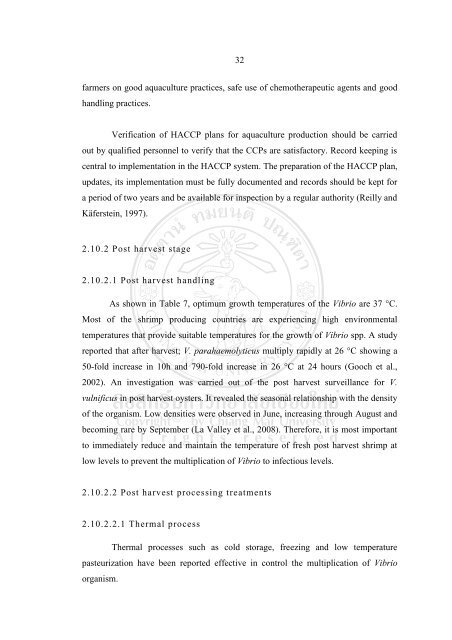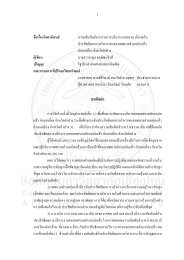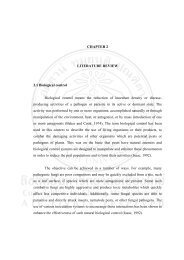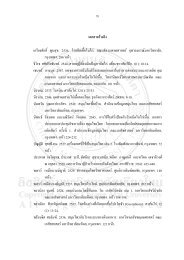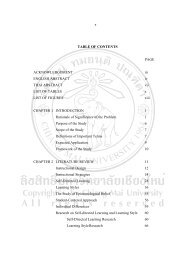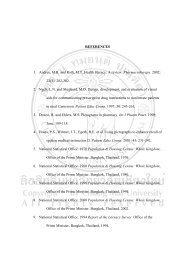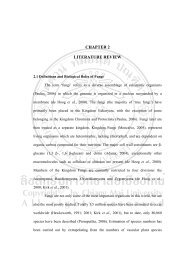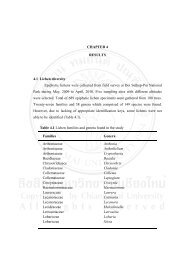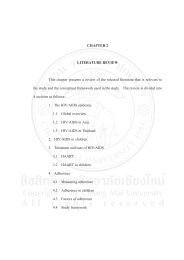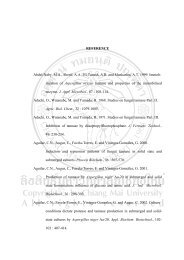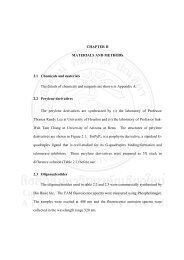prevalence and molecular characteristics of vibrio species in pre ...
prevalence and molecular characteristics of vibrio species in pre ...
prevalence and molecular characteristics of vibrio species in pre ...
Create successful ePaper yourself
Turn your PDF publications into a flip-book with our unique Google optimized e-Paper software.
32<br />
farmers on good aquaculture practices, safe use <strong>of</strong> chemotherapeutic agents <strong>and</strong> good<br />
h<strong>and</strong>l<strong>in</strong>g practices.<br />
Verification <strong>of</strong> HACCP plans for aquaculture production should be carried<br />
out by qualified personnel to verify that the CCPs are satisfactory. Record keep<strong>in</strong>g is<br />
central to implementation <strong>in</strong> the HACCP system. The <strong>pre</strong>paration <strong>of</strong> the HACCP plan,<br />
updates, its implementation must be fully documented <strong>and</strong> records should be kept for<br />
a period <strong>of</strong> two years <strong>and</strong> be available for <strong>in</strong>spection by a regular authority (Reilly <strong>and</strong><br />
Käferste<strong>in</strong>, 1997).<br />
2.10.2 Post harvest stage<br />
2.10.2.1 Post harvest h<strong>and</strong>l<strong>in</strong>g<br />
As shown <strong>in</strong> Table 7, optimum growth temperatures <strong>of</strong> the Vibrio are 37 °C.<br />
Most <strong>of</strong> the shrimp produc<strong>in</strong>g countries are experienc<strong>in</strong>g high environmental<br />
temperatures that provide suitable temperatures for the growth <strong>of</strong> Vibrio spp. A study<br />
reported that after harvest; V. parahaemolyticus multiply rapidly at 26 °C show<strong>in</strong>g a<br />
50-fold <strong>in</strong>crease <strong>in</strong> 10h <strong>and</strong> 790-fold <strong>in</strong>crease <strong>in</strong> 26 °C at 24 hours (Gooch et al.,<br />
2002). An <strong>in</strong>vestigation was carried out <strong>of</strong> the post harvest surveillance for V.<br />
vulnificus <strong>in</strong> post harvest oysters. It revealed the seasonal relationship with the density<br />
<strong>of</strong> the organism. Low densities were observed <strong>in</strong> June, <strong>in</strong>creas<strong>in</strong>g through August <strong>and</strong><br />
becom<strong>in</strong>g rare by September (La Valley et al., 2008). Therefore, it is most important<br />
to immediately reduce <strong>and</strong> ma<strong>in</strong>ta<strong>in</strong> the temperature <strong>of</strong> fresh post harvest shrimp at<br />
low levels to <strong>pre</strong>vent the multiplication <strong>of</strong> Vibrio to <strong>in</strong>fectious levels.<br />
2.10.2.2 Post harvest process<strong>in</strong>g treatments<br />
2.10.2.2.1 Thermal process<br />
Thermal processes such as cold storage, freez<strong>in</strong>g <strong>and</strong> low temperature<br />
pasteurization have been reported effective <strong>in</strong> control the multiplication <strong>of</strong> Vibrio<br />
organism.


